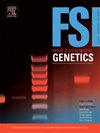结合qPCR和STR扩增进行DNA分析的新方法
IF 3.1
2区 医学
Q2 GENETICS & HEREDITY
引用次数: 0
摘要
开发智能PCR机的第一步是实时监测PCR进展,在扩增STR等位基因时能够修改循环参数。执行qPCR允许实时监测和记录控制位点的扩增:由大小扩增子,阳性对照和Y染色体的一部分组成。该qPCR数据能够记录降解和抑制,因为qPCR期间的荧光理论上应该遵循指数增长。假设,将qPCR与STR扩增相结合可以实时定量荧光,从而可以修改PCR参数以优化STR扩增:荧光低于预期将表明需要修改PCR参数以提高DNA扩增。在本研究中,将两种不同的市售qPCR试剂盒分别与四种不同的STR试剂盒中的一种组合,并记录所得STR图谱的质量。对照对四种STR试剂盒扩增相同数量的DNA模板,所有标准的单扩增和联合扩增进行5次,总共扩增60次。任何组合均未记录到剖面质量或似然比的显著下降。尽管存在两种不同的酶和需要不同温度结合的额外引物,但在实时PCR机上进行STR扩增时没有不良影响。这些数据需要作为智能PCR机的第一步,可以实时调整循环参数。本文章由计算机程序翻译,如有差异,请以英文原文为准。
A novel approach to combine qPCR and STR amplification for DNA profiling
An initial step in the development of a smart PCR machine, capable of amending the cycling parameters when amplifying STR alleles, is to monitor PCR progression in real-time. Performing qPCR allows for the real-time monitoring and recording of amplification of control loci: comprised of a small and large amplicon, a positive control, and a section of the Y chromosome. This qPCR data enables the recording of degradation and inhibition, as the fluorescence during qPCR theoretically should follow an exponential increase. Hypothetically, combining qPCR with STR amplification would allow real-time quantification of fluorescence such that the parameters of the PCR could be modified to optimise STR amplification: fluorescence below expectation would indicate a need to amend the PCR parameters to improve the DNA amplification. In this study, two different commercially available qPCR kits were combined separately with one of four different STR kits, and the resulting STR profile quality was recorded. Controls were performed by amplifying the same quantity of DNA template for each of the four STR kits, with all standard single and combined amplifications performed five times, resulting in 60 amplifications in total. No significant decrease in profile quality or likelihood ratios were recorded for any of the combinations. There were no adverse effects on the STR amplification when performed on a real-time PCR machine, despite two different enzymes and the presence of additional primers requiring differing temperatures to bind. These data are needed as the first step towards a smart PCR machine that can adjust cycling parameters in real-time.
求助全文
通过发布文献求助,成功后即可免费获取论文全文。
去求助
来源期刊
CiteScore
7.50
自引率
32.30%
发文量
132
审稿时长
11.3 weeks
期刊介绍:
Forensic Science International: Genetics is the premier journal in the field of Forensic Genetics. This branch of Forensic Science can be defined as the application of genetics to human and non-human material (in the sense of a science with the purpose of studying inherited characteristics for the analysis of inter- and intra-specific variations in populations) for the resolution of legal conflicts.
The scope of the journal includes:
Forensic applications of human polymorphism.
Testing of paternity and other family relationships, immigration cases, typing of biological stains and tissues from criminal casework, identification of human remains by DNA testing methodologies.
Description of human polymorphisms of forensic interest, with special interest in DNA polymorphisms.
Autosomal DNA polymorphisms, mini- and microsatellites (or short tandem repeats, STRs), single nucleotide polymorphisms (SNPs), X and Y chromosome polymorphisms, mtDNA polymorphisms, and any other type of DNA variation with potential forensic applications.
Non-human DNA polymorphisms for crime scene investigation.
Population genetics of human polymorphisms of forensic interest.
Population data, especially from DNA polymorphisms of interest for the solution of forensic problems.
DNA typing methodologies and strategies.
Biostatistical methods in forensic genetics.
Evaluation of DNA evidence in forensic problems (such as paternity or immigration cases, criminal casework, identification), classical and new statistical approaches.
Standards in forensic genetics.
Recommendations of regulatory bodies concerning methods, markers, interpretation or strategies or proposals for procedural or technical standards.
Quality control.
Quality control and quality assurance strategies, proficiency testing for DNA typing methodologies.
Criminal DNA databases.
Technical, legal and statistical issues.
General ethical and legal issues related to forensic genetics.

 求助内容:
求助内容: 应助结果提醒方式:
应助结果提醒方式:


